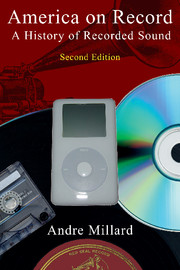Book contents
- Frontmatter
- Dedication
- Contents
- Preface to the second edition
- Preface to the first edition
- Introduction
- Part One The acoustic era
- Part Two The electrical era
- 6 The machines
- 7 Competing technologies
- 8 Empires of sound
- 9 Swing and the mass audience
- 10 High fidelity at last
- 11 Rock'n'roll and the revolution in music
- 12 The record
- 13 The studio
- 14 Perfecting studio recording
- 15 The cassette culture
- Part Three The digital era
- Abbreviations used in the notes
- Notes
- Select discography
- Select bibliography
- Subject index
- Recordings index
- Motion picture index
8 - Empires of sound
from Part Two - The electrical era
Published online by Cambridge University Press: 05 February 2015
- Frontmatter
- Dedication
- Contents
- Preface to the second edition
- Preface to the first edition
- Introduction
- Part One The acoustic era
- Part Two The electrical era
- 6 The machines
- 7 Competing technologies
- 8 Empires of sound
- 9 Swing and the mass audience
- 10 High fidelity at last
- 11 Rock'n'roll and the revolution in music
- 12 The record
- 13 The studio
- 14 Perfecting studio recording
- 15 The cassette culture
- Part Three The digital era
- Abbreviations used in the notes
- Notes
- Select discography
- Select bibliography
- Subject index
- Recordings index
- Motion picture index
Summary
The move to talking pictures required a massive construction program. The cost to rebuild Hollywood's studios ranged from $23 million to $50 million. When compared with the estimate of the value of the original studios, which was around $65 million, this was a staggering amount of capital. Film producers had to borrow millions of dollars to make the conversion to sound. The recovery of these fixed costs pushed them into making the most of their resources by mass-producing films. Although the adoption of these manufacturing techniques had begun before World War I, the transition to sound in the film industry gave it more impetus, pushing the producers to standardize their output and exert more control over production. Sound shaped the way they made films and determined what kind of films they made.
Sound also had a profound effect on the film exhibitors, the businesses which showed the films made by the producers. They were faced with the expense of re-equipping their theaters with special projectors to show talking pictures and installing amplifiers and loudspeakers to reproduce the sound. Depending on the size of the theater, this job could cost over $20,000, and this made it too expensive for small businesses that were often forced to sell out to a larger organization. The independent exhibitors were swallowed up as sound became the standard.
The history of the American film industry is punctuated by struggles between exhibitors and producers. Synchronized sound shifted the balance of power to the film producers, who were encouraged by the prospects of talking pictures to buy theaters and wire them for sound. The studio system that flourished during the Golden Age of Hollywood in the 1930s and 1940s was established by these fully integrated film companies that had moved into sound.
The process of forward integration by film producers into exhibition had begun well before the coming of sound, but the enormous income from talking pictures accelerated the process. The talkies captured the public's attention and created one of the most profitable periods in the history of Hollywood.
- Type
- Chapter
- Information
- America on RecordA History of Recorded Sound, pp. 158 - 175Publisher: Cambridge University PressPrint publication year: 2005



